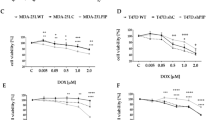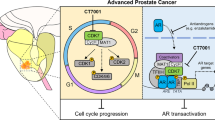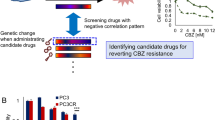Abstract
Aim:
To investigate the cytotoxic effects of four cyclic bisbibenzyls, Riccardin C (Ric), Pakyonol (Pak), Marchantin M (Mar), and Plagiochin E (Pla) against chemoresistant prostate cancer PC3 cells.
Methods:
Cell growth was assayed by MTT method, and apoptotic related protein Bcl-2 and Bax, poly(ADP-ribose) polymerase (PARP) were examined by Western blotting. Cell cycle and apoptosis of PC3 cells were evaluated with flow cytometry and morphologic examinations.
Results:
The four compounds inhibited proliferation and elicited cell death in a dose- and time-dependent manner with IC50 values of 3.22 μmol/L for Ric, 7.98 μmol/L for Pak, 5.45 μmol/L for Mar, and 5.99 μmol/L for Pla, respectively. Furthermore, exposed to these chemicals caused a decrease in the antiapoptotic protein Bcl-2 and an increase in proapoptotic Bax expression. PARP cleavage and caspase-3 activity were also observed.
Conclusion:
The results suggest that cyclic bisbibenzyls could be used for the development of novel therapeutic chemicals against prostate cancer.
Similar content being viewed by others
Log in or create a free account to read this content
Gain free access to this article, as well as selected content from this journal and more on nature.com
or
Abbreviations
- PI:
-
propidium iodide
- PARP:
-
poly(ADP-ribose) polymerase
- Ric:
-
Riccardin C
- Pak:
-
Pakyonol
- Mar:
-
Marchantin M
- Pla:
-
Plagiochin E
- AR:
-
androgen receptor
References
Gurumurthy S, Vasudevan KM, Rangnekar VM . Regulation of apoptosis in prostate cancer. Cancer Metastasis Rev 2001; 20: 225–43.
Lee KH . Anticancer drug design based on plant-derived natural products. J Biomed Sci 1999; 6: 236–50.
Kucuk O . Chemoprevention of prostate cancer. Cancer Metastasis Rev 2002; 21: 111–24.
Barnes S . Role of phytochemicals in prevention and treatment of prostate cancer. Epidemiol Rev 2001; 23: 102–5.
Singh RP, Dhanalakshmi S, Agarwal R . Phytochemicals as cell cycle modulators: a less toxic approach in halting human cancers. Cell Cycle 2002; 1: 156–61.
Asakawa Y, Toyota M, Taira Z, Takemoto T, Kido M . Riccardin A and Riccardin B, two novel cyclic bibenzyls possessing cytotoxicity from the liverwort Riccardia multifida (L.) S. Gray. J Org Chem 1983; 48: 2164–7.
Scher JM, Burgess EJ, Lorimer SD, Perry NB . A cytotoxic sesquiterpene and unprecedented sesquiterpenebisbibenzyl compounds from the liverwort Schistochila glaucescens. Tetrahedron 2002; 58: 7875–82.
Nagashima F, Momosaki S, Watanabe Y, Toyota M, Huneck S, Asakawa Y . Terpenoids and aromatic compounds from six liverworts. Phytochemistry 1996; 41: 207–11.
Qu JB, Xie CF, Guo HF, Yu WT, Lou HX . Antifungal dibenzofuran bis(bibenzyl)s from the liverwort Asterella angusta. Phytochemistry 2007; 68: 1767–74.
Xie CF, Qu JB, Wu XZ, Liu N, Ji M, Lou HX . Antifungal macrocyclic bis(bibenzyls) from the Chinese liverwort Ptagiochasm intermedlum L. Nat Prod Res 2010; Feb 23: 1–6. [Epub ahead of print].
Niu C, Qu JB, Lou HX . Antifungal bis[bibenzyls] from the Chinese liverwort Marchantia polymorpha L. Chem Biodivers 2006; 3: 34–40.
Wang FQ, Lou HX . Chemical studies on the constituents of Plagiochasm intermedium L. Acta Pharmacol Sin 2000; 35: 587–91.
Baek SH, Phipps RK, Perry NB . Antimicrobial chlorinated bibenzyls from the liverwort Riccardia marginata. J Nat Prod 2004; 67: 718–20.
Scher JM, Speakman JB, Zapp J, Becker H . Bioactivity guided isolation of antifungal compounds from the liverwort Bazzania trilobata (L.) S.F. Gray. Phytochemistry 2004; 65: 2583–8.
Kodama M, Shiobara Y, Sumitomo H, Matsumura K, Tsukamoto M, Harada C . Total syntheses of marchantin A and riccardin B, cytotoxic bis(bibenzyls) from liverworts. J Org Chem 1988; 53: 72–7.
Shi YQ, Zhu CJ, Yuan HQ, Li BQ, Gao J, Qu XJ, et al. Marchantin C, a novel microtubule inhibitor from liverwort with anti-tumor activity both in vivo and in vitro. Cancer Lett 2008; 276: 160–1
Shi YQ, Liao YX, Qu XJ, Yuan HQ, Li S, Qu JB, et al. Marchantin C, a macrocyclic bisbibenzyl, induces apoptosis of human glioma A172 cells. Cancer Lett 2008; 262: 173–82.
Shi YQ, Qu XJ, Liao YX, Xie CF, Cheng YN, Li S, et al. Reversal effect of a macrocyclic bisbibenzyl plagiochin E on multidrug resistance in adriamycin-resistant K562/A02 cells. Eur J Pharmacol 2008; 584: 66–71.
Asakawa Y, Bors W, Franck U, Michel C, Muller-Jakic B, Nenninger A, et al. Effect of marchantins and related compounds on 5-lipoxygenase and cyclooxygenase and their antioxidant properties: a structure–activity relationship study. Phytomedicine 1995; 2: 113–7.
Yuan HQ, Kong F, Wang XL, Young C, Hu XY, Lou HX . Inhibitory effect of acetyl-11-keto-β-boswellic acid on androgen receptor by interference of Sp1 binding activity in prostate cancer cells. Biochem Pharmacol 2008; 75: 2112–21.
Nicholson DW, Ali A, Thornberry NA, Vaillancourt JP, Ding CK, Gallant M, et al. Identification and inhibition of the ICE/CED-3 protease necessary for mammalian apoptosis. Nature 2002; 376: 37–43.
Asakawa Y . Biologically active substances found in Hepaticase. Stud Nat Prod Chem 1988; 2: 277–92.
Asakawa Y . Recent advances in phytochemistry of bryophytes-acetogenins, terpenoids and bis(bibenzyl)s from selected Japanese, Taiwanese, New Zealand, Argentinean and European liverworts. Phytochemistry 2001; 56: 297–312.
Feldman BJ, Feldman D . The development of androgen–independent prostate cancer. Nat Rev Cancer 2001; 1: 34–45.
Zegarra-Moro OL, Schmidt LJ, Huang HJ, Tindall DJ . Disruption of androgen receptor function inhibits proliferation of androgen-refractory prostate cancer cells. Cancer Res 2002; 62: 1008–13.
Liao XB, Tang SQ, Thrasher JB, Griebling TL, Li B . Small-interfering RNA-induced androgen receptor silencing leads to apoptotic cell death in prostate cancer. Mol Cancer Ther 2005; 4: 505–15.
Acknowledgements
This work was supported by the National Natural Science Foundation of China (30772594), Shandong Provincial Key Research Foundation (2006GG1102023) and Shandong Scientific Technology Program (2008GG10002042).
Author information
Authors and Affiliations
Corresponding authors
Rights and permissions
About this article
Cite this article
Xu, Ah., Hu, Zm., Qu, Jb. et al. Cyclic bisbibenzyls induce growth arrest and apoptosis of human prostate cancer PC3 cells. Acta Pharmacol Sin 31, 609–615 (2010). https://doi.org/10.1038/aps.2010.37
Received:
Accepted:
Published:
Issue date:
DOI: https://doi.org/10.1038/aps.2010.37
Keywords
This article is cited by
-
Bibenzyls and bisbybenzyls of bryophytic origin as promising source of novel therapeutics: pharmacology, synthesis and structure-activity
DARU Journal of Pharmaceutical Sciences (2020)
-
Marchantin M: a novel inhibitor of proteasome induces autophagic cell death in prostate cancer cells
Cell Death & Disease (2013)
-
Treatment of PC-3 cells with ultrasound combined with microbubbles induces distinct alterations in the expression of Bcl-2 and Bax
Chinese Science Bulletin (2013)



